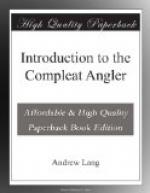whom the last died in 1641—his wife, and
his mother-in-law. In 1644 he left Chancery
Lane, and probably retired from trade. He was,
of course, a Royalist. Speaking of the entry
of the Scots, who came, as one of them said, ‘for
the goods,—and chattels of the English,’
he remarks, ‘I saw and suffered by it.’
{2} He also mentions that he ‘saw’ shops
shut by their owners till Laud should be put to death,
in January 1645. In his Life of Sanderson, Walton
vouches for an anecdote of ‘the knowing and
conscientious King,’ Charles, who, he says, meant
to do public penance for Strafford’s death,
and for the abolishing of Episcopacy in Scotland.
But the condition, ’peaceable possession of
the Crown,’ was not granted to Charles, nor
could have been granted to a prince who wished to
reintroduce Bishops in Scotland. Walton had his
information from Dr. Morley. On Nov. 25, 1645,
Walton probably wrote, though John Marriott signed,
an Address to the Reader, printed, in 1646, with Quarles’s
Shepherd’s Eclogues. The piece is
a little idyll in prose, and ‘angle, lines,
and flies’ are not omitted in the description
of ‘the fruitful month of May,’ while Pan
is implored to restore Arcadian peace to Britannia,
’and grant that each honest shepherd may again
sit under his own vine and fig-tree, and feed his
own flock,’ when the King comes, no doubt.
‘About’ 1646 Walton married Anne, half-sister
of Bishop Ken, a lady ‘of much Christian meeknesse.’
Sir Harris Nicolas thinks that he only visited Stafford
occasionally, in these troubled years. He mentions
fishing in ‘Shawford brook’; he was likely
to fish wherever there was water, and the brook flowed
through land which, as Mr. Marston shows, he acquired
about 1656. In 1650 a child was born to Walton
in Clerkenwell; it died, but another, Isaac, was born
in September 1651. In 1651 he published the
Reliquiae Wottonianae, with a Memoir of Sir
Henry Wotton. The knight had valued Walton’s
company as a cure for ’those splenetic vapours
that are called hypochondriacal.’
Worcester fight was on September 3, 1651; the king
was defeated, and fled, escaping, thanks to a stand
made by Wogan, and to the loyalty of Mistress Jane
Lane, and of many other faithful adherents. A
jewel of Charles’s, the lesser George, was preserved
by Colonel Blague, who intrusted it to Mr. Barlow
of Blore Pipe House, in Staffordshire. Mr. Barlow
gave it to Mr. Milward, a Royalist prisoner in Stafford,
and he, in turn, intrusted it to Walton, who managed
to convey it to Colonel Blague in the Tower.
The colonel escaped, and the George was given back
to the king. Ashmole, who tells the story, mentions
Walton as ’well beloved of all good men.’
This incident is, perhaps, the only known adventure
in the long life of old Izaak. The peaceful angler,
with a royal jewel in his pocket, must have encountered
many dangers on the highway. He was a man of
sixty when he published his Compleat Angler
in 1653, and so secured immortality. The quiet




